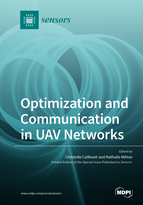Optimization and Communication in UAV Networks
A special issue of Sensors (ISSN 1424-8220). This special issue belongs to the section "Sensor Networks".
Deadline for manuscript submissions: closed (31 March 2020) | Viewed by 42595
Special Issue Editors
Interests: Internet of Things; wireless sensor networks; RFID; wireless robots networks; services (localization, neighbor discovery, etc)
Special Issues, Collections and Topics in MDPI journals
Special Issue Information
Dear Colleagues,
With new technological advances, UAVs are becoming a reality and attract more and more attention. UAVs or drones are flying devices that can be remotely controlled or, more recently, completely autonomous. They can be used alone or as a fleet, and in a large set of applications: From rescue operations to event coverage going through servicing other networks such as sensor networks for replacing, recharging, or data offloading. They are hardware-constrained since they cannot be too heavy and rely on batteries. Depending on their use (alone or in a swarm) and the targeted applications, they must evolve differently and meet different requirements (energy preservation, delay of covering an area, coverage, limited number of devices, etc.) with limited resources (energy, speed, etc.).
Yet, their use still raises a large set of new exciting challenges, in terms of trajectory optimization, positioning, when they are used alone or in cooperation, coordination, and communication when they evolve in swarm, just to name a few.
This Special Issue calls for any new original submissions that deal with UAV or UAV swarm optimization or communication aspects.
Dr. Nathalie Mitton
Dr. Christelle Caillouet
Guest Editors
Manuscript Submission Information
Manuscripts should be submitted online at www.mdpi.com by registering and logging in to this website. Once you are registered, click here to go to the submission form. Manuscripts can be submitted until the deadline. All submissions that pass pre-check are peer-reviewed. Accepted papers will be published continuously in the journal (as soon as accepted) and will be listed together on the special issue website. Research articles, review articles as well as short communications are invited. For planned papers, a title and short abstract (about 100 words) can be sent to the Editorial Office for announcement on this website.
Submitted manuscripts should not have been published previously, nor be under consideration for publication elsewhere (except conference proceedings papers). All manuscripts are thoroughly refereed through a single-blind peer-review process. A guide for authors and other relevant information for submission of manuscripts is available on the Instructions for Authors page. Sensors is an international peer-reviewed open access semimonthly journal published by MDPI.
Please visit the Instructions for Authors page before submitting a manuscript. The Article Processing Charge (APC) for publication in this open access journal is 2600 CHF (Swiss Francs). Submitted papers should be well formatted and use good English. Authors may use MDPI's English editing service prior to publication or during author revisions.
Keywords
- UAV
- Drones
- Wireless
- Self-organization
- Optimization
- Swarm
- Communication
- Algorithms








